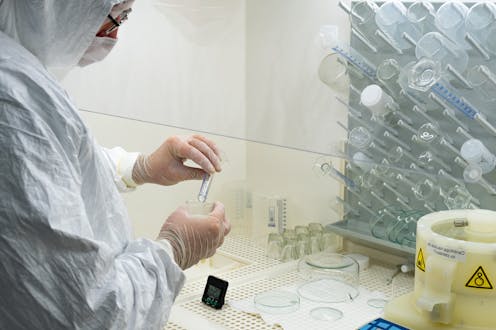What's the new Omicron XE variant and should I be worried?
- Written by Paul Griffin, Associate Professor, Infectious Diseases and Microbiology, The University of Queensland

It seems every few weeks we hear about a new COVID variant, and it’s hard to know how concerned we ought to be.
A “recombinant” variant has emerged, dubbed “Omicron XE”, which is the result of two omicron strains merging together in a single host and then going on to infect others.
So what do we know about this new hybrid, and do we need to worry?
Read more: What's the difference between mutations, variants and strains? A guide to COVID terminology[1]
A bit about Omicron and its variants
Omicron is a variant of the SARS-CoV-2 virus that was first discovered[2] in Botswana on November 11 2021 and designated a variant of concern[3] by the WHO on November 26. Since this time, it has been transmitted worldwide and replaced Delta to become the dominant variant.
Omicron has since continued to evolve to have multiple different lineages, or genetically related subvariants. This includes the original Omicron BA.1 (B.1.1.529) and also BA.2 and BA.3.
BA.2 is more infectious[4] than BA.1 and has now taken over or outcompeted BA.1 to become the new dominant form of the SARS-CoV-2 virus worldwide, with the WHO officially announcing[5] this to be the case on March 22 2022.
The differences we have seen with Omicron relative to previous variants are explained by the relatively large number of mutations it has acquired, with 60 mutations not found in the original virus arising from Wuhan, China.
Among these mutations are 32 genetic changes in the spike protein. The spike protein is the part of the virus it uses to attach to human cells, as well as the target of the immune response against the virus, from both vaccines and prior infection.
BA.2 shares many of these same mutations as the original Omicron variant, but also has 28 unique genetic changes of its own. Four of these genetic changes are in the spike protein, which explains why some of its characteristics are different to the original Omicron variant (BA.1), including the fact it appears to be approximately 30 to 50% more infectious[6] than BA.1.
Read more: BA.2 is like Omicron's sister. Here's what we know about it so far[7]
What’s a ‘recombinant’?
Just as we have seen new variants arise, followed by the evolution of subvariants or different lineages, the SARS-CoV-2 virus has continued to change in other ways as well. In recent times we have seen not just spontaneous changes in the genetic code that have accounted for the changes described above, but also so-called recombinants.
A recombinant is where related viruses exchange genetic material to create offspring with genetic material from both parent viruses. This can arise when viruses of two different strains (or variants or subvariants) co-infect the same cell.
The genetic material of the viruses can get mixed and packaged together to make a new recombinant virus, with properties of either or both parent viruses. The properties of the recombinant virus therefore depend on which parts of the genetic material from the parent viruses make it into the new version – just like you might have your mum’s nose and your dad’s knees.
When Delta and Omicron recombine, the resulting progeny have been referred to as “Deltacron” (although more officially these are referred to as XD and XF). This type of recombinant was first identified in France in mid-February and seems to have[8] a genetic sequence mostly the same as Delta, but with aspects of the spike protein from Omicron BA.1.
So what is XE and where is it spreading?
XE is a recombination of BA.1 and BA.2. There are many other BA.1 and BA.2 recombinants, including XQ in the UK, XG from Denmark, XJ from Finland and XK from Belgium.
While XE still comprises a small proportion of total sequenced cases, it has shown evidence of community transmission, at least within England where it was first detected in mid-January. There have now been just over 1,100 cases[9] recorded.
It has also been identified in India, China and Thailand. Initially the growth rate for XE appeared to not be significantly different from BA.2, but more recent data from the UK suggests it has a growth rate[10] of around 10 to 20% above that of BA.2.
This data remains preliminary and based on small numbers, so may change as we get more information. If it is true, then this means XE is likely to be slightly more contagious than BA.2, which was slightly more contagious than BA.1, which was more contagious than Delta.
Do we need to worry?
Our immune response that helps to protect against COVID-19 is generated by vaccination or from previous infection, and it mostly targets the spike protein. Given XE basically has the same spike protein as BA.2, it doesn’t appear our protection against XE will be significantly reduced.
While this is something public health agencies and expert groups certainly should monitor, and they are, it isn’t really something that is unexpected given the number of cases we continue to see worldwide. So it shouldn’t be a cause of extra concern for the general public.
The best way to slow the emergence of new variants, as well as recombinants, remains having as many people in the world protected by vaccination to reduce the pool of susceptible hosts in which these events can occur.
References
- ^ What's the difference between mutations, variants and strains? A guide to COVID terminology (theconversation.com)
- ^ first discovered (www.nature.com)
- ^ designated a variant of concern (www.who.int)
- ^ more infectious (www.who.int)
- ^ officially announcing (www.who.int)
- ^ more infectious (www.scientificamerican.com)
- ^ BA.2 is like Omicron's sister. Here's what we know about it so far (theconversation.com)
- ^ seems to have (www.bmj.com)
- ^ 1,100 cases (www.gov.uk)
- ^ growth rate (assets.publishing.service.gov.uk)
Read more https://theconversation.com/whats-the-new-omicron-xe-variant-and-should-i-be-worried-180584

















